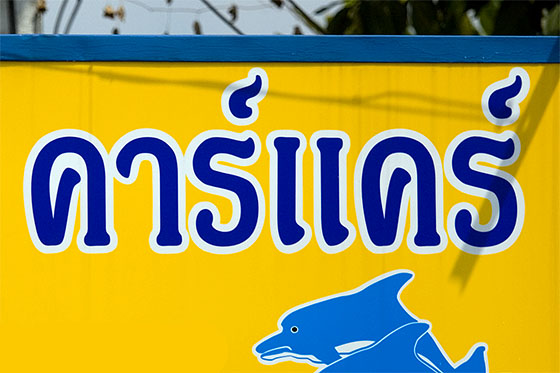Learn How To Read Thai - Tutorial 21
Symbols
We have already seen that Thai has four tone marks (Tutorial 14) and in Tutorial 16 we met the vowel shortener symbol.
These are all written above the Thai letters, as are some Thai vowels; so do not confuse symbols, tone marks, and vowels.
I'm going to cover three more symbols today. One is written above and the other two are written after the Thai script.
The first is:
ๆ
It is known as mai yuh-mok in Thai. The Thai script is as follows:
ไม้ยมก
This symbol is written after a word and indicates that the word should be repeated. Why? It's because Thais repeat some words in order to give emphasis. Here is an example:
บ่อย ๆ
The first character bor bai mai makes a 'b' sound (Tutorial 3) and this is followed by or aang and yor yuk that make an 'oy' sound (Tutorial 11). The word therefore sounds like 'boy'.
You will see that mai yuh-mok is written after this word and therefore it becomes boy-boy as this symbol indicates the word must be repeated.
The Thai word boy means often and when repeated means very often.
Tone: Mid-class initial consonant and first tone mark = Low tone (Tutorial 14)

Here's another good example of a font used in a Thai sign that is quite difficult to read. Once you've started learning from books, the next big obstacle is learning how to decipher fonts used in the real world.
This word starts off with an 'ng' initial consonant, it has a long 'aa' vowel and a 'yor yuk' final consonant. The word is 'ngaay' and means easy in Thai. The mai yuh-mok symbol that follows indicates that the word should be repeated. ngaay ngaay means very easy.
Tone: Low-class initial consonant and first tone mark = Falling tone (Tutorial 14)
The following photo is typical of how Thais advertise. They don't bother with newspapers or the Internet but just attach a piece of card to the nearest lamppost. You might be looking for something and there might be adverts for exactly what you want but if you can't read Thai you will just walk straight past.
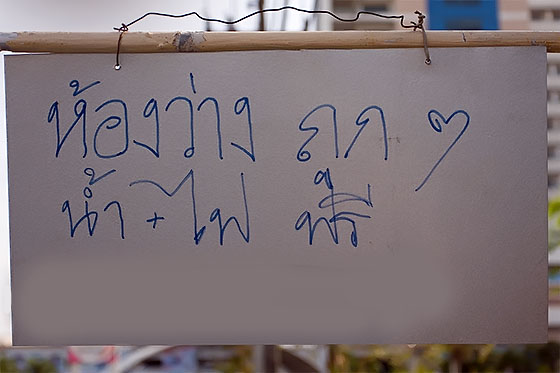
In the previous tutorials you will find everything you need to know to be able to read this sign. I am including it here because it gives an example of mai yuh-mok.
The top line reads hong waang (room available). Written after it is the following:
ถูก ๆ
Again, you should be able to read this word without any problems if you have been following these tutorials as I intended. The Thai word took means cheap. Following it is mai yuh-mok which means that the word is repeated. took-took means very cheap (and not a strange looking little vehicle often seen in Thailand).
You should also be able to read the rest of the sign. It says that water and electricity are free. Reading Thai at this level is really easy and it's also very useful.
The literacy rate is very high in Thailand, however, despite most Thais being able to read it doesn't mean they will obey signs.
Thailand has the second highest road fatality rate in the world and although many accidents are caused by drunk driving, the number one cause of accidents is excessive speed. Many Thais drive way too fast and way too close to other vehicles.
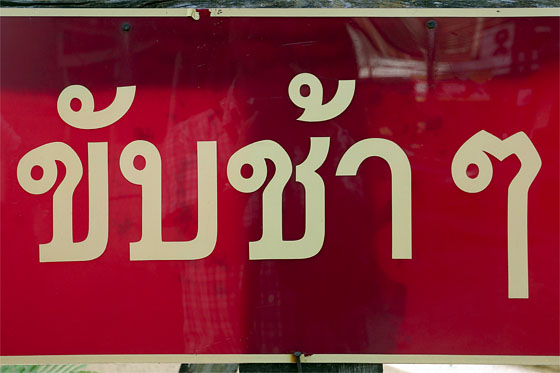
The Thai word for 'drive' is 'kup' and the word for 'slow' is 'chaa'. Using the mai yuh-mok symbol doubles up 'slow' to emphasise to drivers to drive very slowly - 'kup chaa chaa'. Unfortunately in Thailand, signs such as this one are a complete waste of time.
The next symbol is:
ฯ
It is known as bpai yaan-noy in Thai. Here is the Thai script:
ไปยาลน้อย
It is written after abbreviated versions of long words or place names. You will see this used with different words and place names depending on where you are in Thailand. The full Thai version of Bangkok is incredibly long, and gruung-tayp is just an abbreviation.

The Thai word for Bangkok is gruung-tayp so after this word you may see bpai yaan-noy. However, the Thai word for Bangkok doesn't always include bpai yaan-noy.

Living in the south, I most often see it used for Nakorn Sri Thammarat. On buses they just write the first word (nakorn) and then use bpai yaan-noy to show it is an abbreviation.
This next symbol appears often and is written above the characters. It is known as gaa-run in Thai:
การันต์
David Smyth refers to it as the 'consonant killer' symbol and my SE-ED Thai to English dictionary calls it a mute mark. When you see it, you know that you can ignore the character (or characters) below.
In the Thai script written above for the name of the symbol, it gives an example. You can see gor gai (Tutorial 1) followed by the long 'aa' vowel (Tutorial 7) to give gaa. Then we have ror reua (Tutorial 2), with mai-hun-aagaat (Tutorial 2) written above it followed by nor noo (Tutorial 8) to give run.
gaa-run is all we need but at the end is dtor dtao, which we don't need. To indicate that we don't need this letter, gaa-run is written above it.
This may be sounding a little perverse by now. Why take the trouble to include a character (or characters) you don't need, and then include a symbol to indicate it, or they, aren't necessary?
Whenever you see this symbol used it is a clue that the word has been 'borrowed' from another language. That other language could be English, or it could be Pali or Sanskrit.
This symbol also appears often when English words have been transliterated into Thai script.
It's a result of Thai consideration and respect for the other language. When Thai has 'borrowed' a word from another language the Thais have made an attempt to retain the original spelling. If, to do this, they include characters that are surplus to requirements then gaa-run is used to tell the reader they aren't required.
Some examples might help to explain this more clearly and there is a good example in the photo of a sign at the top of the page.
The sign says:
คาร์แคร์
This two word sign uses English words transliterated into Thai. The company offers some kind of vehicle valeting service and wants to use the English words 'Car Care'.
The first word begins with Kor Kwaay (Tutorial 5) and is followed by the long 'aa' vowel (Tutorial 7).
In Thai, this is all that is required. We already have the sound kaa which is as close to 'car' as you will get. The Thais want to be considerate though and the English word they borrowed has an 'r' on the end.
What they have done is stuck the Thai consonant that makes an 'r' sound ror reua (Tutorial 2) on the end but it is unnecessary. Because it is unnecessary they have used the gaa-run symbol above.
The second word follows the same logic.
The first character is the Thai vowel sara air (Tutorial 16) followed by Kor Kwaay (Tutorial 5). This vowel is written before the consonant so we get kair. That's all we need to approximate the English word 'care'.
We don't need anything else but once again, the English word uses an 'r' which is unnecessary in Thai so the Thais have done the same thing. They have added ror reua but used the gaa-run symbol above to show it is unnecessary.
If they did this but didn't use gaa-run it would cause problems. As I pointed out in Tutorial 2, ror reua has an 'n' sound if used as a final consonant so if this consonant was pronounced it would turn the sign into 'karn kairn'.
Here's another one:
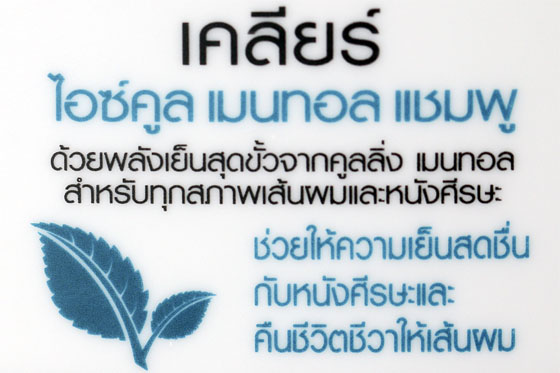
This foreign brand of shampoo is called 'Clear'. There is no Thai sound for 'ear', but there is a vowel combination that makes an 'ear-uh' sound, so this is what they have used (Tutorial 24). Thus, in Thai it becomes 'clear-uh'.
Following English-Thai transliteration convention, they then stick a ror reua at the end because the English word has an 'r', but because it isn't required they add a gaa-run.
If you read some of the other words that have been transliterated from English to Thai you will see some of the other problems. For example, with English words that end with an 'l' (such as 'cool' and 'menthol' the Thai consonant lor ling is used. As you now know from these tutorials, this Thai character makes and 'n' sound when used as a final consonant and that creates an obvious problem.
Sounds that exist in English, such as the 'th' in 'menthol' don't exist in Thai and that creates yet another problem.
The shampoo bottle also demonstrates the Thai disdain for final consonants. Many English words that are transliterated in Thai get the gaa-run treatment on the final consonant and thus on this label 'Ice' becomes 'ai'.
Thailand had no concept of beer until it was introduced from the West. In addition to importing the product, they also imported the word 'beer'. However, the same thing happened as happened to 'clear'. 'Beer' became 'beer-uh' or 'bia'. Whichever way you transliterate, it has two syllables.
On my desk calendar I can see that gaa-run is used in four Thai names for days of the week. This tells me that those names have come into Thai from another language - probably ancient Sanskrit.
What I can see also reminds me that even when gaa-run is used, there can be other letters that are ignored in addition to the ones written below gaa-run. Here's an example:
จันทร์
This is the Thai word for Monday - jun. It is normally prefixed by the word for day (wun) so it becomes wun jun.
The first three characters give us jun. The first consonant is jor jaan (Tutorial 19) and written above it is mai-hun-aagaat (Tutorial 2). The final consonant is nor noo (Tutorial 8).
That's all we need.
However, we then have tor tuh-haan (Tutorial 15) and ror reua (Tutorial 2). You can see gaa-run above ror reua so you know you don't pronounce the final consonant, but neither do you pronounce tor tuh-haan (the penultimate consonant) and that doesn't have gaa-run.
How do you know?
How do you know in English how to pronounce Leicester? There are some things that you just need to know.
Unused Consonants Without gaa-run
There are quite a few words in Thai that have consonants that aren't used and, just to make life a bit more confusing, they don't use gaa-run. The main culprit seems to be ror reua.
For example, the Thai word for 'card, ticket, coupon' etc.
บัตร
This is just 'but' - you can ignore the ror reua at the end.
After reading Thai for a while you start to remember certain spellings and in some cases you instinctively know when a consonant is written but not voiced. These redundant consonants often appear at the end of words. However, there are still lots of words that are confusing if you don't know them, and this is especially the case if redundant consonants appear in the middle of a word.
The following word means 'to be able, to be capable of, to have the ability to do something':
สามารถ
If I didn't know this word, I would pronounce it as 'saa-maa-rot'. This is because the ror reua looks to be fully functional. Nothing indicates that it isn't. However, it is redundant. Therefore, the word is pronounced 'saa-maat'.
Overall, I think that written Thai is more logical than written English. Just try explaining the different pronunciation of 'ough' to a foreigner when used in different words. However, there are also some anomalies in Thai.
More Reverse Transliteration
Transliterating Thai words using the English alphabet is a disaster, but it is just as much of a disaster when Thais write English words using Thai script. Such signs often cause me problems trying to read them, but they can also explain why Thais pronounce English words the way they do.
Here's an example:

The sign starts with mor maa (Tutorial 8) and written underneath it is sara oo (Tutorial 18). This is followed by for fun (Tutorial 17) and these three letters make up the first syllable. When for fun is used as a final consonant it makes an unreleased 'p' sound, so we get moop.
The next syllable begins with wor wairn (Tutorial 9) and above it is written sara ee (Tutorial 3), so we get wee.
On to the next word, and the first character is the vowel sara ai mai-muh-laay (Tutorial 8). After it is written one of the 't' consonants tor tuh-haan (Tutorial 15).
The final consonant is mor maa (Tutorial 8) but it has gaa-run written above it so it isn't pronounced. Therefore, what we have is: moop-wee tai. This isn't a Thai phrase; it's supposed to be an English one. Any ideas?
This sign is for a shop that rents movies on DVD and it is an attempt to transliterate 'Movie time' into Thai script. The trouble is that the right sounds simply do not exist in Thai so when Thais attempt to transliterate from English it's a disaster.
When pronouncing English words Thais don't pronounce the final consonant, which they seem to think is unimportant. To be polite, they write the equivalent Thai consonant but then stick gaa-run above it so that it gets ignored.
It's the same with 'motorcycle' which becomes moto-sai and 'science' which becomes sai. The way they transliterate foreign words reinforces their bad pronunciation.
This is another reason to ban transliteration.
When transliterating English words into Thai, Thais use gaa-run to cancel out final consonants that are actually wanted. When transliterating Thai words into English that use gaa-run in order to cancel out the consonant, the transliteration includes the unwanted consonant. It's crazy.
Some Thai words have consonants or short vowels at the end of the word that aren't pronounced, and which don't have gaa-run either. The superfluous consonants and/or vowels are written in Thai but not voiced. When these words are transliterated into English, the unwanted letters are written and voiced. It's ridiculous.
Thailand's new international airport in Bangkok is written in Thai with an unvoiced 'i' at the end. This 'i' should just have been ignored when the word was transliterated, but it wasn't. When foreigners see the transliterated word they naturally pronounce the 'i'. Thai does not have a 'v' sound. Foreigners pronouncing Thai words incorrectly because of disastrous transliteration must make Thais very confused. The transliteration of this word is horrendous.
สุวรรณภูมิ
The standard confusing transliteration is Suvarnabhumi, but it is actually pronounced suu-wun-nuh-poom
While Thaksin was at Manchester City the fans called him Frank Sinatra because his surname is transliterated as Shinawatra. Written in Thai, there is a ror reua on the end which is unvoiced. There isn't a gaa-run to show that it isn't voiced.
The transliteration not only adds a superfluous 'r', but to make it really confusing adds a superfluous 'a' as well.
ชินวัตร
His name is pronounced shin-uh-wut.
Tourists who think they are being clever in Thailand ordering 'Singha' beer just make fools of themselves adding the superfluous 'ha'. When Thais hear this they think to themselves, "Ha ha ha - here comes another stupid farang. Let's see how much we can rip this one off for."
If you look at the Thai spelling there is an 'h' character at the end but it is cancelled out by gaa-run. There is no 'h' and there is definitely no 'a'. If you want to sound as if you know a bit about Thailand, ask for a bia sing, not a 'Singha beer'.
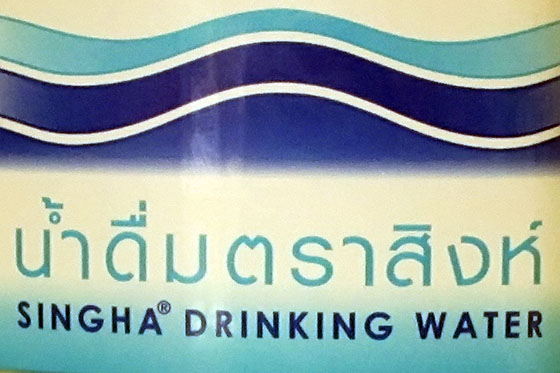
I've said it a thousand times and I will say it again. Transliteration is a nightmare. It doesn't matter if you are transliterating from Thai to English or English to Thai, the results are equally as disastrous.
It is best avoided and the only way to avoid it is by learning to read Thai. If you study, understand and remember the short tutorials I have written here you will never need to use transliteration again. I gave it up years ago.
Questions And Feedback
If you have any comments, questions or suggestions, feel free to contact me. Your feedback will help me to improve these pages.
Recommended Books
Amazon UK
Amazon UK
Amazon US
Amazon US

